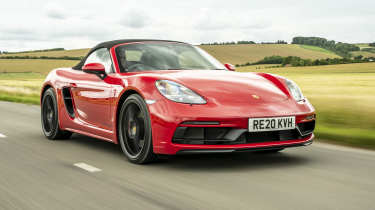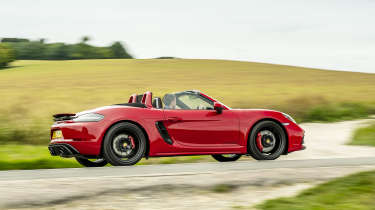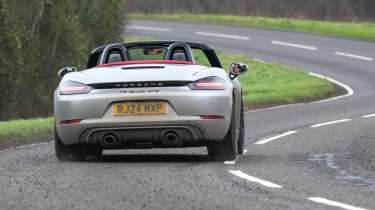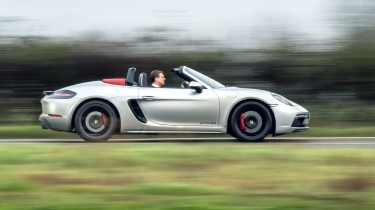Porsche 718 Boxster GTS 4.0 2025 review – six-cylinder drop-top is best in class
For the authentic Boxster experience, the six-cylinder GTS 4.0 is the best way to get it
There’s just something so pure about the notion of the six-cylinder Porsche Boxster in 2025. Forget about hybrids, active all-wheel-drive systems or even turbocharging. The reality is that if you’re after a pure sports car experience, Porsche is just about the only mainstream manufacturer to still offer it in the 718 Boxster GTS 4.0.
When being specific about the GTS 4.0, it’s impossible not to notice how the Boxster has hardly changed since it was first introduced in 1996. It still utilises a lightweight mixed-metal chassis, with a flat-six engine mounted behind the driver but ahead of the rear axle. The cabin is compact, with two seats and what remains one of the neatest folding fabric roofs in the business, plus it still has room at both ends for luggage.
> Electric Porsche Cayman and Boxster spied: 600bhp sports car gears up for launch
There’s two transmission options, manual and auto, although the original five-speed manual and Tiptronic units have been replaced with a six-speed manual and seven-speed PDK dual-clutch. Of course, the numbers are also now much more serious in terms of performance and price points, but at its heart the Boxster GTS 4.0 remains everything the original always was – a near-as-dammit perfect sports car.
More reviews
The flat-six GTS 4.0 joined the range in 2020, replacing a previous GTS that was powered by a turbocharged flat-four engine. Rather than using the GT department’s exotic and expensive high-revving flat-six, the GTS 4.0 instead uses the standard 911 Carrera’s turbocharged 3-litre unit as a base, installing a selection of changes unique to the 718 range. As well as the removal of the turbos, it’s heavily bored out, creating almost an extra full litre of swept capability. In this instance it produces 394bhp at 7000rpm with a 7800rpm cut out, and has 310lb ft of torque. This is essentially the same powertrain as found in the more serious (and more compromised) Boxster Spyder, albeit with a little less power, but exactly the same torque.
The six-speed manual has a fractionally longer shift action than in the Spyder, but the gearing is identical, allowing 85mph in second. On a track this can make the GTS feel a touch long-geared, but on the road there is sufficient torque to pull such long gearing without serious issue.
In the PDK box, first gear is little more than a launch ratio, while second feels very short indeed, and is only really for tighter hairpins. But given the closer relationship between second, third and fourth gears, there’s a far greater chance of repeatedly accessing the higher echelons of the GTS’ rev band than in the manual version, where letting the car bury deep into the upper reaches of third gear means travelling at well over the ton. The ramifications, potentially, of which are obvious.
Of course, you can leave the PDK to its own devices - you may well do that in daily driving, and in normal mode it does the easy, sleepy, early-shift thing that you’d expect. It also does maximum attack, too, but there’s no substitute for pulling the paddles (decent feel to the mechanism, a bit on the small side though), even if there’s also no substitute ultimately for three pedals and taking care of it all yourself, certainly if it’s driving involvement you’re after. Predictably, the PDK-equipped Boxster GTS is a fair chunk quicker off the line to 60mph, by half a second no less, but then raw speed is far from everything on the road.
The outright performance of the Boxster GTS is all but identical to that of the Spyder, with zero to 62mph taking a claimed 4.5sec (Spyder 4.4sec). Zero to 100mph takes a whisker over nine seconds (Spyder a whisker under nine) while the top speed is 182mph (Spyder 187mph).
Yet despite not revving quite as high as in the GT4, it’s still a stunning engine to work with, exhibiting all the same inherent characteristics. This includes the superb response and pick up at low rpm – something that’s especially valuable given the manual’s long gear ratios.
The chassis, on the other hand, takes a few steps back because you don’t get the Spyder/GT4’s rose-jointed front end, which as you’ll know was lifted pretty much lock-stock from the 991.2 GT3, nor do you get the extra stiffening bar at the back. The Boxster GTS is therefore more of a tuned S, rather than a knocked-back Spyder, although its brakes are bespoke: bigger than those of the S, smaller than you get on a Spyder/GT4, with optional carbon-ceramics available.
Subjectively, the biggest differences between the 718 Spyder and the Boxster GTS on the road are the way in which their suspension systems respond, and the grip they can generate from the different tyres they wear. The more expensive Spyder comes on bespoke Michelin Pilot Sport Cup 2s, while the GTS rides on regular Pirelli P Zeros.
Even on the road, the more conservative tyres of the GTS allied to the different front suspension design means the GTS doesn’t ever feel quite as pin-sharp as the Spyder, but it’s not as far off as you might imagine. It’s a little bit less focused, a little bit less manic in its responses generally, a touch more comfortable and, therefore, a fair bit more useable as a road car overall.
The GTS’s more approachable demeanour has other benefits, too. With less grip, the GTS has more approachable limits at road speeds, letting you more easily experience the superb chassis balance. Excessive oversteer isn’t the name of the game here, there just isn’t the torque to sustain anything too lairy in dry conditions, but you can overdrive the Boxster GTS with that little bit more confidence. The pin-sharp yet relatively low-geared steering reigns things in a little, but helps you create a flow. Get greedy with your speed going into tighter bends and the front end won’t hesitate to push.
The car we drove was fitted with the optional bucket seats and carbon-ceramic brakes. These provide immense stopping power, and great feel, but it’s the engine that dominates the experience, providing good thrust from 2500rpm and a hair-raising noise between 5000rpm and the 7800rpm cut out.
Don’t think of the Boxster GTS as a Spyder-lite dynamically, but a Boxster with the correct engine. Less a flex of the Porsche’s engineering muscle and instead a reflection on what made the Boxster such an icon in the first place. Yet this experience will soon be a fleeting one, as Porsche gets closer to launching the Boxster and Cayman’s electric replacement. The modern 718’s story has been dominated by the GT4, Spyder and more recently the GT4 RS, and while each of these models is astoundingly good in its own individual way, no modern 718 channels the essence of a Boxster quite like the GTS 4.0.
Prices and rivals
At £77,300, the Boxster GTS seems like astonishingly good value given that it shares the same engine with the more expensive 718 Spyder. An Audi R8 Spyder cost over twice as much when it was on sale, but is no more engaging to drive. The same goes for the Mercedes-AMG SL. And if you think the slightly cheaper BMW Z4 is anywhere near the same league as the new flat-six Boxster GTS, think again. Truth is, at this money the GTS has no serious rivals.
Overall, the GTS recipe is a compelling one: yes, the fact that the GTS interior package is £2096 when you’re already buying a ‘GTS’ model is an options ploy only Porsche could get away with, but given its so far beyond any potential rival, it's well worth its price.







